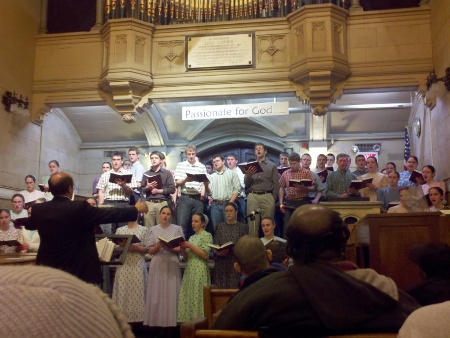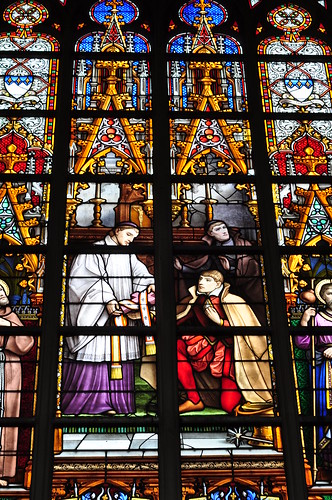
In a May 2014 letter in The Mennonite, C. Norman Kraus asked whether the role of Mennonite Church USA Executive Director (ED) and has begun to look like a "new papal office." He said, "…are we not loading an institutional position with official authority that our polity does not accommodate?"
By bringing the pope into it, Kraus is drawing attention to some important questions about how the ED functions. Stay with me as we take a journey through the crufty corners of Mennonite bureaucracy and bylaws. It’s hard slogging, but it matters.
The response from Executive Board and Executive Director
Elizabeth Soto Albrecht and Ed Diller, current MC USA moderator and a former moderator of the EB respectively, responded to Kraus in an August 2014 letter to the editor in which they stated that "…there is no papal office in Mennonite Church USA.". They went on to defend the current role of ED with this mandate from the bylaws: "an Executive Director as a primary administrative officer who shall be its principal agent in the management of Mennonite Church USA."
Managing Mennonite Church USA… sounds pretty dramatic, eh? They left out the next point, which makes the organizational scope of the role sound a bit less grandiose: "The Executive Director shall conduct the administrative affairs of the Executive Board, serve as an officer, and supervise employees of Mennonite Church USA." The Mennonite Church USA being managed is an organization with a staff of 25 people, not the 90,000+ members of the denomination.
(more…)
TimN
October 8, 2014
Change, Mennonite Church USA, Politics, Pope, Power
Read more >
We are Anabaptists. We are Mennonites. We are distinct from other Protestants and denominations. We care about peace, justice, community. We are a unique and special people.
Many of us feel this way or at least I know, at times, I do. There is a special quality of Christianity that is evidenced in Anabaptism. Yes, we were persecuted by the Holy Catholic Church, but we were also persecuted by fellow Protestants. There is severity and deep conviction in our confession of faith.
Yet, in truth, too often we rest on the laurels of our Anabaptist forebears. We recall or express nostalgia for the countercultural, anti-empire sentiments and actions of those who came before us, all the while colluding with the current empire on many levels in our life. Some of us (even unwittingly) invest in stocks for pharmaceutical corporations and weapons manufacturers, thus endorsing a system that benefit from death and destruction.
Many persons and whole churches have substituted absolute pacifism with Just War Theory. In that regard we have embraced Augustinean Christianity to the detriment of Jesus’ command to love even our enemies who persecute and abuse us. We claim a Mennonite identity, but too often embrace an American identity or political ideology (whether left or right). We fail to recognize the radical calling upon our lives, which is to root ourselves in a Christ identity.
Some of us need a fresh baptism, a next baptism to awaken us to Christ’s calling upon our lives. We may have been baptized in water, but now we need a fire baptism to burn out the iniquity and inequality that pervades our lives. Like a prairie fire that burns the dead things and promotes richer soil, so too do we need the Spirit of fire to prepare us to live more deeply and richly. (more…)
JasonS
August 20, 2014
activism, Anabaptism, antiracism, Biographical, Books, Change, Church, Class, Community, Conscientious Objection, Economics, empire, Martyrdom, Mennonite Church USA, Military, neo-Anabaptism, New Monasticism, Nonviolence, Peace & Peacemaking, Social justice, Social movements, Spiritual Life, Stories, Urban Ministry, Writing
Read more >
There is a growing movement of pastors, church planters, and churches around the globe who have become convinced that the center of the Gospel is a Jesus-looking God who calls his people to partner with him to advance a Jesus-looking kingdom. Â They sense that God is pouring out “new kingdom wine” that is bursting apart the tired old wineskins of Christendom. They sense we are at the cusp of a rising kingdom revolution that is going to radically alter what people identity as “the Christian faith” and “the Church.” Â The majority of these leaders are both encouraged and discouraged. They are encouraged by the Jesus-looking kingdom revolution they see rising up, Â but discouraged by the lack of networking and partnership amongst others who share their convictions. –Greg Boyd and Mark Moore
Several weeks ago, Greg Boyd and Mark Moore hosted a network exploration meeting for Neo Anabaptist types in the hours leading up to the conference on “Faith, Doubt and the Idol of Certainty.” The conference, hosted by Woodland Hills Church, was slated to coincide with the recent release of Boyd’s latest book, Benefit of the Doubt. (which I hear is highly worth reading)
But it was the Neo Anabaptist “network exploration meeting” that became the basis of buzz amongst online Anabaptist circles as of late.
There certainly seems to be a need for cohesion among the emerging Neo Anabaptist churches and pastors across the country–something that goes beyond denominationalism, but can work in tandem with existing avenues (such as denominations) that many of us already have relationships with. Many think we have an opportunity to create a missional organization or association that empowers “the boots on the ground,” so to speak–a platform for Post Christendom theology and praxis.
Perhaps it is time to start bringing together minds and bodies in order to create a space for open resources, networking, and mutual affirmation. Still, the conversation thus far has given me pause, and so I want to highlight a few pitfalls to I think we should avoid as well as present a few proposals that cast some vision for the Post Christendom Reformation.
The Pitfalls
1) We need to acknowledge our privilege:
What I am not seeing so far is a space that creates agency for women, minorities, the marginalized as well as those who aren’t “big” theological personalities in the current Neo Anabaptist discussion. Let’s be honest: while I applaud Mark Moore and Greg Boyd for taking the initiative to invite Neo Anabaptist types into dialogue as an aside to this conference, I fail to see how hosting a “network exploration meeting” opens the space for the diversity the movement is already composed of, when the only ones who could attend such a meeting must have either
a) been conference town locals, or
b) have the time and means to fly to the Twin Cities and attend Greg’s conference. (more…)
TylerT
October 9, 2013
Anabaptism, antiracism, Bigotry, Change, Church, Class, Community, disabilities, Education, Emerging Church, empire, Ethics, Evangelism, Exclusion, Global ChurchAnabaptist, Anabaptist Theology, Charity Hill Erickson, greg boyd, Mark Moore, Missional, Neo Anabaptist, Peace Reformation, Post Christendom America, Tyler Tully, Woodland Hills Church
Read more >
This story was originally published over at The Jesus Event. You can click HERE to be a part of the conversation there, or you can post your own thoughts and opinions here at YAR.
Greg Boyd recently spoke about his journey from Oneness towards something else–a story which he highlights in this video entitled “From Baptist to Anabaptist.”
Some of you might remember my recent interview with friend and fellow San Antonian Brian LePort, concerning his journey (very similar to Boyd’s) from Oneness Pentecostalism to a more ecumenical, Anabaptist fellowship. Today, Brian’s blog conversation touches on his ongoing encounter with the Anabaptist movement, and much of what he has to say resonates with those of us who have been recently participating in Anabaptistica as non-ethnic Mennonite/Amish/Beachy/Hutterite/Brethren. While I am personally attracted to Anabaptist theology and praxis (e.g. its Incarnational Christology, emphasis on discipleship in Jesus, holistic implications of the Gospel, etc.), I’m also frustrated with a few things that I truly believe need to be addressed by the “institutional” Anabaptist traditions at large in the United States. FWIW, the reflections I offer below are meant to be taken in the tone of a lover’s quarrel instead of a schismatic diatribe: (more…)
TylerT
August 30, 2013
Change, Church, City, Emerging Church, Mennonite Church USAAnabaptist, black, Brian LePort, buxy cavey, david fitch, Drew GI Hart, greg boyd, margins, MCUSA, Mennonite, mike krause, Oneness, praxis, Radical Anabaptist, San Antonio, Theology, Tyler Tully
Read more >
“I will tell you something about stories . . . They aren’t just entertainment. Don’t be fooled. They are all we have, you see, all we have to fight off illness and death.”
~Leslie Marmon Silko
I truly believe that sharing our stories–including the actual process of writing them out–is one of our most powerful tools–a small act that starts a transformation in ourselves and the world around us. What if sharing our stories could help future generations of both men and women? What if a story could “overturn a table” in the various Temples of our day– including in the bellies of our own communities and congregations? Social media’s given more women affiliated with Mennonite Church USA a chance to get a glimpse of the diversity and reality present in our national congregations and communities–a reality and diversity that’s not always heard or lived out, let alone celebrated.
Let’s change that. Every step and every story counts.
Wanted: Stories from any woman or girl who considers herself Mennonite or shaped by the Anabaptist-Mennonite traditions. Check out the newly launched Mennonite Monologues web site where stories can be told through essays, poems, art, songs, photographs, and other forms of creative expression. The Women and Leadership Project needs stories that speak to your truth and experience: joy and gratitude, as well as stories of lament and pain. Multiple stories are encouraged. Whatever story you wish to tell, it is welcome. All will be collected on our blog and may be submitted with a name or anonymously.
“Women have often felt insane when cleaving to the truth of our experience. Our future depends on the sanity of each of us, and we have a profound stake, beyond the personal, in the project of describing our reality as candidly and fully as we can to each other.”
~Adrienne Rich
Prompts to help get you started
-As a woman, what are the stories that have shaped your sense of leadership?
-What are your experiences of being called (or not called) to leadership in Mennonite Church USA?
-How have you been empowered by the church to lead?
-How have you been discouraged from taking on leadership roles?
-Do you think there is a difference in the ways women and men are cultivated to be leaders?
-Did you grow up seeing women in leadership?
-Who were your mentors?
-What is your ideal vision of church leadership in the future? Where do you fit in?
YAR, we need your awesomely radical selves! Thanks for helping to spread the word. ~Women in Leadership Project, Mennonite Monologues team
BeccaJayne
July 9, 2013
activism, Anabaptism, Blog, Change, Community, Education, Gender, Mennonite Church USA, Peace & Peacemaking, Sexism, Uncategorized, WritingFeminism, peacemaking, undoing sexism, Women in Leadership
Read more >
The original Anabaptists’ intention was to attend to their Lord and their God’s will in a manner that was satisfying. However, there was an accompanying goal that is seamlessly interconnected with the initial one. This objective was to reconstitute the ekklesia in the pattern of the archetypical first century apostolic assembly. To reconstitute something is “to constitute again or anew; especially…to restore to a former condition” according to Merriam-Webster Dictionary. According to The Blackwell Companion to Political Theology the Anabaptists “saw the church as “fallen” and therefore beyond mere reform, and called for its reconstitution along New Testament lines” (70).
Roger Olson goes into greater detail regarding this objective in The Story of Christian Theology: Twenty Centuries of Tradition & Reform when he explains that the Anabaptists were more protestant than Protestants in the sense that the Anabaptists:
“protested what they saw as halfway measures taken by Luther and the other magisterial Reformers in purifying the church of Roman Catholic elements. Their ideal was to restore the New Testament church as a persecuted remnant as it was in the Roman Empire before Constantine. To them, the magisterial Reformers were all stuck in Constantinianism and Augustinianism. These were the two main diseases of medieval Christianity that the radical Reformers wished to eradicate from their own independent and autonomous congregations, if not from Christianity itself” (415).
The Protestant Reformers desired to reform the Church, according to the above-mentioned dictionary to reform means “to put or change into an improved form or condition”. It also means, “to amend or improve by change of form or removal of faults or abuses” and finally “to put an end to (an evil) by enforcing or introducing a better method or course of action”.
(more…)
AOG
March 24, 2013
Anabaptism, Change, Church, Group Identity, Roman Catholic, Schism
Read more >
Hi, YAR family! It’s literally been years (years!) since I’ve written to fellow YAR readers here in our online sanctuary. Though I’ve been silent here, know that your existence has buoyed me and challenged me in my Anabaptist seeking.
Why do we write, anyway? To an audience of one, to loved ones and complete strangers? After finally visiting with an insurance agent yesterday (who’d been emailing and calling like I was a close friend who’d been putting off a brunch date), I found that I needed to make sense of my unease and questions about “insuring” a better world as a 21st-century Mennonite. Writing is my go-to in these cases. An act of faith, so to speak.
So here’s something for our collective offering plate: http://tattooedmennonite.blogspot.com/2013/01/insurance-and-wordles.html
BeccaJayne
January 30, 2013
activism, Anabaptism, Change, Economics, Wealth, Writing
Read more >
Michael J (MJ) Sharp, was an occasional contributor here in the early days and the founder of a precursor to YAR, the Mennonite Progressives list. This week he was tweeting from Goma in the far east of the Democratic Republic of Congo as M23 rebels closed in on the city. It’s a great example of how Twitter can be used for first hand, grassroots reporting in conflict areas with a two way component not found in conventional media. (more…)
TimN
November 24, 2012
Change, Democratic Republic of Congo, MCC, Military, Peace & Peacemaking
Read more >
Love, compassion, joy, and equanimity are some of the hallmarks of the teachings of Jesus. But those concepts didn’t originate with Jesus.
He found them tucked away in the nooks and crannies of the Torah. Almost every saying in the Sermon on the Mount is a commentary on passages from the Hebrew Scriptures. The genius of Jesus was the way in which he put his own “spin” on the Scriptures, highlighting and elevating the positive aspects of God’s personality, while ignoring and rejecting the negative aspects.
The ideals of love, compassion, joy, and equanimity weren’t the unique property of the Judaic tradition, however. They could also be found earlier, and further east, in what is now India, Nepal, Bhutan. In the Fifth Century before Jesus, a man named Gotoma developed a body of teachings based on what are called “The Four Immeasurables”: (more…)
CharlieK
June 18, 2012
Anabaptism, Awesome Stuff, Change, Church, City, Civilization, communication, Community, Contemplation, culture, Current Events, Dumb Stuff., Education, End Times, Ethics, Evangelism, extinction, Foreign Policy, Global Church, God, Group Identity, History, Indigenous, Interfaith, International Relations, Judaism, Love, MCC, Mennonite Church USA, Nonviolence, The Bible, Tolerance, Urban Ministry
Read more >
…
Picture this:
As the new millennium dawns, anabaptists do a new thing in the city: Build a communal neighborhood populated by tens of thousands of simple-living sectarians.
The project is initiated by the Bruderhof and some Old Order Amish, partly for practical reasons: (1) the Amish and Bruderhof population explosions, making it necessary to continually branch out and establish new settlements; and (2) the shortage of affordable farmland, making it difficult to maintain a rural way of life.
More importantly, the initiative stems from a “quickening” amongst these plain people, who realize they’ve lost their ancestral impulse for going into the marketplaces & street corners, inviting others to become co-workers in God’s kingdom. They also realize geographical isolation no longer protects them against worldly influences. So they branch out to the Bronx, where they can influence the world instead.
(more…)
CharlieK
January 18, 2012
Anabaptism, Awesome Stuff, Change, City, Civilization, Community, End Times, Ethics, Group Identity, Love, Nonviolence, Peace & Peacemaking, Sex, Tolerance, Urban Ministry, Wealth, Young Folks
Read more >
We are Marginal Mennonites, and we are not ashamed.
We are marginal because no self-respecting Mennonite organization would have us. (Not that we care about no stinkin’ respect anyway.)
We reject all creeds, doctrines, dogmas and rituals, because they’re man-made and were created for the purpose of excluding people. Their primary function is to determine who’s in (those who accept the creeds) and who’s out (those who don’t). The earliest anabaptists were also non-creedal.
We are inclusive. There are no dues or fees for membership. The only requirement is the desire to identify oneself as a Marginal Mennonite. We have no protocol for exclusion.
We are universalists. We believe every person who’s ever lived gets a seat at the celestial banquet table. No questions asked! Mystic-humanist (and anabaptist) Hans Denck was quoted saying that “even demons in the end will be saved.”
We reject missionary activity. Christian mission, historically, goes hand-in-hand with cultural extermination. We love human diversity and seek to preserve it. Thus, we oppose evangelistic campaigns and mission boards, no matter how innocuous or charitable they claim to be.
We like Jesus. A lot. The real Jesus, not the supernatural one. We like the one who was 100% human, who moved around in space and time. The one who enjoyed the company of women and was obsessed with the kingdom of God. The one who said “Become passersby!” (Gospel of Thomas 42), which we interpret as an anti-automobile sentiment. (more…)
CharlieK
November 7, 2011
Anabaptism, Awesome Stuff, Change, City, culture, Dumb Stuff., End Times, Ethics, Evangelism, Exclusion, Fun, God, Group Identity, History, Interfaith, Interpretation, Love, Mennonite Church USA, Nonviolence, Pornography, Schism, Sex, The Bible, Tolerance, Urban Ministry, Wealth, Young Folks
Read more >
October 6 marks the 10-year anniversary of the United States’ war in Afghanistan. In response to this event and the stories of woman in war zones around the world, Women’s Action for New Directions (WAND) in the United States plans to rally “women and thoughtful men” around the U.S. to proclaim that this war has gone on 10 years too long and demand “not one more death allowed” and “not one more dollar spent” on this war. They join the thousands who continue the “Occupy Wall Street” protests and direct-democracy actions in New York and many other cities and towns across the U.S.
The anniversary of this war marks the years of my journey doing feminist anti-war organizing (with WAND, Mennonites, and others). It is a formation that began in the early days of this war in 2001 when, as a senior at a Mennonite high school, I became pen pals with a young woman who lived in Nazareth. She spoke Arabic and English. I spoke English and Spanish. We didn’t know anything else about each others’ realities. Through English-language letters over the next year, we began to paint a picture of daily life across the world for one another.
I never imagined that 10 years later there would still be a U.S.-led war in Afghanistan.
I never imagined that 10 years later I would live in Jerusalem, not far from Nazareth. (more…)
ST
October 14, 2011
activism, Books, Change, Current Events, International Relations, liberation theology, MCC, Palestine, Peace & Peacemaking
Read more >

There’s a building boom on the Bowery these days. It’s been happening for a while, but the last couple years have witnessed an escalation in development, turning the neighborhood into a hip destination point.
Fifty years ago the Bowery was the largest skid row in the world. There were gin joints and flophouses on every block. That’s all gone now, thanks to the forces of gentrification. In their place are condos, art galleries and upscale eateries. Only one skid-row relic remains: the Bowery Mission.
Some of my earliest memories are of sitting behind the Mission’s pulpit in the 1960s, looking onto a sea of expectant faces while my father preached. In retrospect I realize the men behind those faces were awaiting the sermon’s conclusion so they could get their grub. (more…)
CharlieK
August 22, 2011
Anabaptism, Biographical, Change, Church, City, Civilization, Consumerism, culture, Current Events, Economics, Education, Ethics, Evangelism, Exclusion, God, Group Identity, History, Interfaith, Love, Mennonite Church USA, Mental health, Nonviolence, philosophy, Polarization, poverty, Power, Privilege, Race, Schism, Sex, Spiritual Life, Stewardship, Stories, The Bible, Theology, Tolerance, Tradition, Urban Ministry, Wealth
Read more >

In the first article of this series, I did a broad overview of the bureaucratization trends in the Mennonite Church. In the second article, I looked specifically at the philosophy of institutions put forth by J. Lawrence Burkholder and practiced by James Brenneman and Howard Brenneman as presidents of Goshen (Ind.) College and Mennonite Mutual Aid respectively. In this third part I’ll look at the history of this thought in the Anabaptist tradition as well as Mennonite and feminist critique of Neihbur and Burkholder. I’ll continue to draw heavily from The Limits of Perfection: A Conversation with J. Lawrence Burkholder as well as The Feminist Case against Bureaucracy.
(more…)
TimN
March 21, 2011
Anabaptism, Change, Institutions, Mennonite Church USA, Power, Sexism
Read more >

When we left the first part in this series, I promised that the second part would look specifically at Mennonite educational organizations and the case of James Brenneman and J. Lawrence Burkholder. However, I’d like to start by giving some background on J. Lawrence Burkholder and his influence with another Mennonite institution: the institution formerly known as Mennonite Mutual Aid (MMA), now Everence.
I first became familiar with this story in Keith Graber Miller’s piece “Mennonite Mutual Aid: A Margin of Difference.” In it he tells the story of MMA adopting the practice of underwriting. The practice meant that healthier people would pay less for their insurance policies and sicker people would pay more or be denied coverage all together. It was seen by some in MMA’s leadership as necessary for the survival of the institution. Underwriting had become the norm among most insurance companies at the time. But in practice, it would have a painful impact on sick or at-risk people who would be denied coverage, and it was difficult for those in MMA who were responsible for denying them aid in their time of need. In 1988, an MMA task force went so far as to say that strict underwriting was “contrary to the mission of MMA.” The report also said, “We are caught between those conflicting needs of serving the church and being a sound business.”
(more…)
TimN
March 7, 2011
Change, Mennonite Church USA
Read more >



